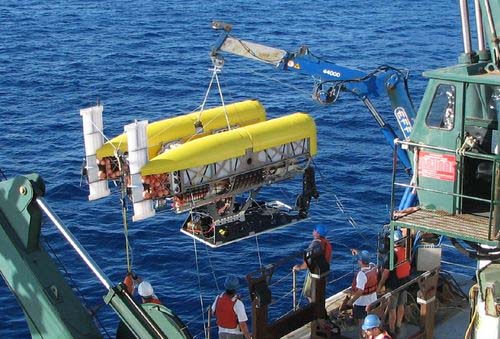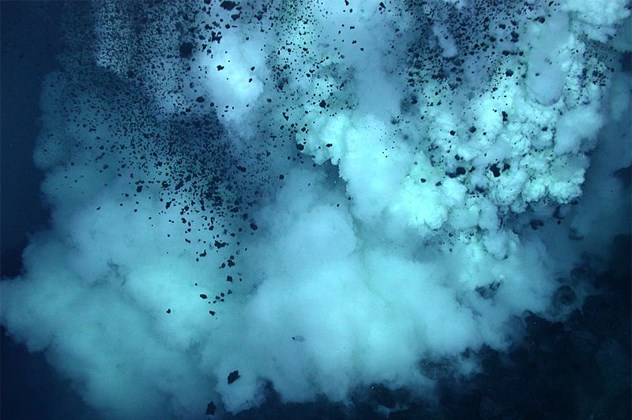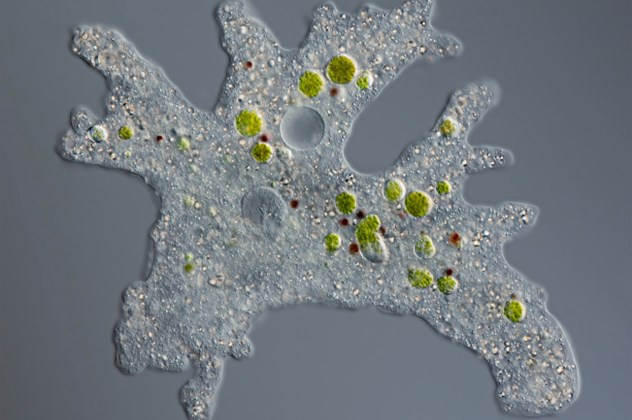Discover groove secrets Mariana
The mysterious environment in the deepest part of the sea, which is also the deepest place in the world, is slowly being discovered by the scientific community.
Explore the earth's deepest ocean groove

The Mariana trench mission mission currently depends on the probe.(Photo: NSF)
The Mariana Trench , located in the western Pacific Ocean, extends to Japan, is the deepest part of the ocean , with a maximum depth of 10,971m. The team of international scientists, led by Professor Ronnie Glud of the University of Southern Denmark, used a specially designed submersible to be able to withstand terrible pressure as the main vehicle for research. the bottom part of the groove Mariana.
BBC leads the initial survey results showing, Mariana grooves, as well as other ocean trenches, acting as carbon sinks for Earth . This suggests that they may play a much larger role in regulating the chemical and climate mechanisms of our planet.

Although the two explorers Jacques Piccard and Don Walsh reached the deepest part of the Mariana trench in 1960, no one dared to think about repeating that record. And these groove research missions have been taken by unmanned devices.
Lead researcher Ronnie Glud said working at the depths of the Mariana trench, at more than 1,000 atmospheres, was a challenge for the long-term scientist. However, the constant progress of technology has changed this. This is the first time scientists can build complex devices for measuring in the Mariana Trench to determine how much carbon is being buried here, he said .
 Giant poisonous insects with body length up to 10 cm under the Mariana groove
Giant poisonous insects with body length up to 10 cm under the Mariana groove
Under enormous pressure
Professor Glud, in collaboration with experts from the Japan Marine Science and Technology Agency (Jamstec) and England, Germany, used probes fitted with special sensors inside titanium and needle cylinders. The type can withstand extremely high pressure.

The jellyfish glows in the groove of Mariana - (Photo: Rense.com)
The device was dropped by the mother ship from the sea surface and it took 3 hours to free fall to the seabed, where it conducted pre-programmed experiments before removing all the ballast to float back to the surface. .
These experiments help the team to reach the abundant source of carbon at such depths. Professor Glud said: ' Basically, we would love to learn more about the quantity of organic matter, all of which is produced by algae or fish in the upper layer of water, lying on the seabed, and whether they are bacteria food, either disintegrated or buried . '
 Champagne mouth of the Mariana groove becomes famous because it is a place that contains hydrothermal holes that emit pure liquid carbon dioxide.
Champagne mouth of the Mariana groove becomes famous because it is a place that contains hydrothermal holes that emit pure liquid carbon dioxide.
According to him, the proportion of organic matter decomposed or buried is the final process that determines the concentration of oxygen and carbon dioxide (CO2) in the oceans and in the atmosphere, thereby drawing a picture. Overview of the ability of the ocean to attract and sequester carbon in the global carbon cycle.
While this has been studied in other parts of the ocean, such as the deep sea plain at depths of 4.6 to 5.5 km, the role of deep-sea trenches in the carbon cycle is almost still absent. carefully researched.
 The bottom of the trench is not a fine sand as you imagine a thick and slippery mud formed from thousands of thousands of corpses of plankton.
The bottom of the trench is not a fine sand as you imagine a thick and slippery mud formed from thousands of thousands of corpses of plankton.
According to Professor Glud, although these grooves account for only 2% of the oceans, his team thinks their role is extremely important because they can accumulate a lot of carbon , attracting many organic matter. More muscles drift from other places.
The data obtained initially shows that they are absolutely right. Professor Glud said: ' Our results suggest that it is very certain that these trenches act as sediment traps. And they work with o ' capacity .
 Daikoku volcano is located under the Mariana trench at a depth of 414 m.The volcano in the sea is not a strange phenomenon, but Daikoku is very special thanks to the possession of a pure liquid sulfur lake.
Daikoku volcano is located under the Mariana trench at a depth of 414 m.The volcano in the sea is not a strange phenomenon, but Daikoku is very special thanks to the possession of a pure liquid sulfur lake.
Now the team of experts began to move on to the next step, which is to assess the collected results and determine the amount of carbon stored in the trench bottom compared to other places in the ocean, as well as the amount of carbon due to bacteria transformable.
This is not the first time the scientific world is surprised by the findings from the deep sea groove. Recent studies by the University of Aberdeen (UK) show that marine life in this place is more abundant than people think.

In 2008, they shot the fish that lived in the deepest part of the ocean, at a depth of 7,700 meters in the Japanese trench, and other creatures such as crustaceans were present in a deeper place.
- UAV 'Vityaz' will be able to create the first 3D map of the Mariana groove
- Listen to the mysterious sound obtained from the deepest
- Revealing new ecosystems under the deepest
- Japan found fish in the deep groove 8,188m under the sea
- Video: Jellyfish in the deepest ocean ditch in the world
- Appearance of the Earth when ocean water is absorbed
- 3-hour diary under the deepest Mariana region of film director Titanic
- American explorer dives into the deepest ocean trench in the world
- Video: How deep is the ocean?
- The special body of fish lives at a depth of 8,178 meters
- Find the deepest seabed in the world
- What's in the deepest place on Earth?
 'Fine laughs' - Scary and painful torture in ancient times
'Fine laughs' - Scary and painful torture in ancient times The sequence of numbers 142857 of the Egyptian pyramids is known as the strangest number in the world - Why?
The sequence of numbers 142857 of the Egyptian pyramids is known as the strangest number in the world - Why? Miracle behind the world's largest stone Buddha statue
Miracle behind the world's largest stone Buddha statue What is alum?
What is alum?